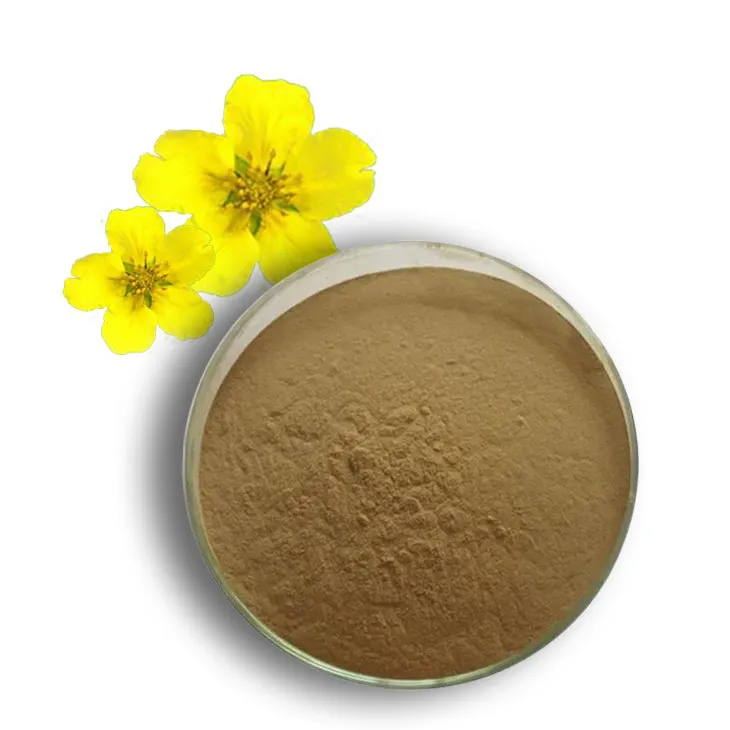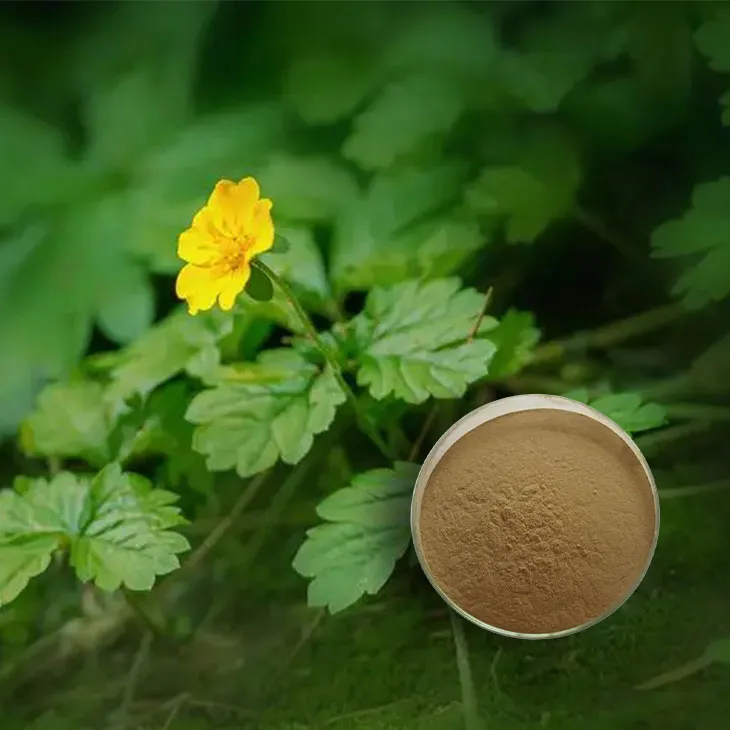- 0086-571-85302990
- sales@greenskybio.com
Extraction process of tormentil extract.
2024-11-29

1. Introduction
Tormentil (Potentilla erecta) is a plant that has been used in traditional medicine for various purposes. The extract of tormentil contains valuable compounds such as tannins, flavonoids, and phenolic acids. These compounds are responsible for its antioxidant, anti - inflammatory, and antimicrobial properties. The extraction process of Tormentil Extract is a complex procedure that involves several steps, including raw material selection, extraction methods, and purification steps. This article will provide an in - depth exploration of these aspects.

2. Raw material selection
2.1. Source and quality
- The raw material for Tormentil Extract is the root of the tormentil plant. It is important to select high - quality roots for extraction. The roots should be collected from a clean and unpolluted environment.
- Wild - harvested roots should be sourced from areas where the plant is not endangered and where sustainable harvesting practices are followed. Alternatively, cultivated tormentil can also be used as a source of raw material.
- The harvesting time of tormentil roots can significantly affect the quality and quantity of the extractable compounds. Generally, the roots are best harvested in the autumn when the plant has accumulated a relatively high amount of active compounds.
- Harvesting too early or too late may result in lower yields or reduced quality of the extract.
- After harvesting, the roots need to be properly cleaned to remove soil, debris, and other impurities. This can be done by washing the roots thoroughly with water.
- The cleaned roots are then dried. Drying can be carried out in a well - ventilated area at a relatively low temperature (around 30 - 40°C) to avoid the degradation of active compounds. Once dried, the roots can be ground into a fine powder for further extraction.

3. Extraction methods
3.1. Solvent extraction
-
3.1.1. Choice of solvent
- Solvents play a crucial role in the extraction of Tormentil Extract. Commonly used solvents include ethanol, methanol, and water. Ethanol is a popular choice as it is relatively safe, has good solubility for many of the active compounds in tormentil, and is easily removable during the purification process.
- Methanol also has good extraction capabilities but is more toxic and requires more careful handling. Water can be used alone or in combination with organic solvents. The choice of solvent depends on the target compounds to be extracted and the subsequent applications of the extract.
-
3.1.2. Extraction procedure
- First, a certain ratio of solvent to the powdered tormentil root is prepared. For example, a common ratio could be 1:10 (weight/volume) of root powder to solvent.
- The mixture is then placed in a suitable extraction vessel, such as a flask or a Soxhlet extractor. In the case of Soxhlet extraction, the solvent is continuously recycled through the sample, which can ensure a more complete extraction.
- The extraction is carried out at a specific temperature and for a certain period of time. For example, when using ethanol as a solvent, the extraction may be carried out at around 50 - 60°C for 2 - 4 hours in a simple reflux extraction setup.
- After extraction, the resulting solution, which contains the tormentil extract and the solvent, is separated from the solid residue by filtration or centrifugation.
-
3.2.1. Principle
- Supercritical fluid extraction uses a supercritical fluid, typically carbon dioxide (CO₂), as the extraction medium. A supercritical fluid has properties between those of a gas and a liquid. CO₂ is often chosen because it is non - toxic, non - flammable, and has a relatively low critical temperature (31.1°C) and pressure (73.8 bar), which makes it easy to handle in industrial settings.
- The solubility of the target compounds in the supercritical CO₂ can be adjusted by changing the pressure and temperature conditions. This allows for selective extraction of different components from the tormentil root.
-
3.2.2. Procedure
- The powdered tormentil root is placed in an extraction chamber. The supercritical CO₂ is then pumped into the chamber at a specific pressure and temperature. For example, a pressure of 150 - 300 bar and a temperature of 40 - 60°C may be used.
- The supercritical CO₂ extracts the active compounds from the root. The extract - laden CO₂ is then passed through a separator where the pressure is reduced, causing the CO₂ to return to its gaseous state and the extract to be collected.
- One advantage of SFE is that it can produce a relatively pure extract with minimal solvent residue compared to solvent extraction methods.

4. Purification steps
4.1. Filtration and centrifugation
- After the extraction process, the initial extract may still contain some solid particles, such as cell debris or undissolved plant material. Filtration is the first step in purification. A filter with an appropriate pore size, such as a 0.45 - μm or 0.22 - μm membrane filter, can be used to remove these particles.
- Centrifugation can also be used as an alternative or complementary method to filtration. By spinning the extract at a high speed, the heavier particles are forced to the bottom of the centrifuge tube, allowing for the separation of the supernatant, which contains the purified extract.
- The extract obtained after filtration or centrifugation usually contains a large amount of solvent. Evaporation is used to remove the solvent and concentrate the extract. For solvent - based extracts, simple evaporation under reduced pressure can be carried out using a rotary evaporator.
- The temperature and pressure conditions during evaporation need to be carefully controlled to avoid the degradation of the active compounds. Once the solvent is removed, a more concentrated extract is obtained.
-
4.3.1. Column chromatography
- Column chromatography is a common method for further purifying the tormentil extract. A column is packed with a suitable stationary phase, such as silica gel or a polymeric resin. The extract is then loaded onto the column.
- Different solvents or solvent mixtures are used as the mobile phase to elute the compounds from the column. Compounds with different polarities will be eluted at different times, allowing for the separation and purification of specific components in the extract.
-
4.3.2. High - performance liquid chromatography (HPLC)
- HPLC is a more advanced chromatographic technique that can achieve high - resolution separation of the components in the tormentil extract. It uses a high - pressure pump to force the mobile phase through a column packed with a fine - particle stationary phase.
- The elution profile can be monitored using a detector, such as a UV - Vis detector. HPLC can be used to purify specific compounds in the extract or to analyze the composition of the extract with high precision.
5. Conclusion
The extraction process of tormentil extract is a multi - step procedure that requires careful attention to raw material selection, extraction methods, and purification steps. Each step plays a crucial role in obtaining a high - quality extract with a rich content of active compounds. The choice of extraction method depends on various factors, including the target compounds, cost, and scale of production. Purification steps are necessary to remove impurities and obtain a pure and concentrated extract. With the increasing demand for natural products with beneficial health properties, the extraction of tormentil extract is likely to gain more attention in the future, both in the fields of traditional medicine and modern pharmaceutical research.
FAQ:
What are the key factors in selecting raw materials for tormentil extract?
The key factors in selecting raw materials for tormentil extract mainly include the quality and maturity of the tormentil plants. High - quality plants are usually those that are healthy, free from diseases and pests, and grown in suitable environmental conditions. The maturity of the plants also affects the content and quality of the active ingredients. For example, plants harvested at the optimal growth stage are more likely to contain a higher concentration of the desired compounds for extraction.
What are the common extraction methods for tormentil extract?
Common extraction methods for tormentil extract include solvent extraction. Solvent extraction often uses solvents such as ethanol or methanol. Maceration is a typical approach within solvent extraction, where the tormentil raw materials are soaked in the solvent for a certain period to allow the active ingredients to dissolve into the solvent. Another method could be Soxhlet extraction, which is a continuous extraction process that can efficiently extract the active components from the raw materials.
How is the purification of tormentil extract carried out?
The purification of tormentil extract can be achieved through several techniques. One common method is filtration, which can remove solid impurities from the extract. Filtration can be done using filter papers or more advanced filtration devices. Another approach is chromatography. For example, column chromatography can be used to separate different components in the extract based on their different affinities to the stationary and mobile phases, thus purifying the tormentil extract.
What are the main active ingredients in tormentil extract?
The main active ingredients in tormentil extract include tannins. Tannins have various biological activities such as antioxidant and antibacterial properties. Additionally, tormentil extract may also contain flavonoids, which are known for their potential health - promoting effects like anti - inflammatory activities.
What are the challenges in the extraction process of tormentil extract?
One of the challenges in the extraction process of tormentil extract is the selection of the appropriate extraction method to ensure high yield and purity of the active ingredients. Different extraction methods may have different extraction efficiencies and may also affect the quality of the extract. Another challenge is the purification process, as it needs to remove impurities effectively without losing the important active components. Moreover, the stability of the active ingredients during the extraction and purification processes also needs to be considered.
Related literature
- Optimization of the Extraction Process of Tormentil Active Compounds"
- "Study on the Chemical Composition and Extraction of Tormentil"
- "Advanced Techniques in Tormentil Extract Purification"
- ▶ Hesperidin
- ▶ Citrus Bioflavonoids
- ▶ Plant Extract
- ▶ lycopene
- ▶ Diosmin
- ▶ Grape seed extract
- ▶ Sea buckthorn Juice Powder
- ▶ Fruit Juice Powder
- ▶ Hops Extract
- ▶ Artichoke Extract
- ▶ Mushroom extract
- ▶ Astaxanthin
- ▶ Green Tea Extract
- ▶ Curcumin
- ▶ Horse Chestnut Extract
- ▶ Other Product
- ▶ Boswellia Serrata Extract
- ▶ Resveratrol
- ▶ Marigold Extract
- ▶ Grape Leaf Extract
- ▶ New Product
- ▶ Aminolevulinic acid
- ▶ Cranberry Extract
- ▶ Red Yeast Rice
- ▶ Red Wine Extract
-
Baicalin
2024-11-29
-
Grape Leaf Extract
2024-11-29
-
Red Date Extract
2024-11-29
-
Yellow Pine Extract
2024-11-29
-
Uridine-5'-monophosphate Disodium salt
2024-11-29
-
Coconut Water Powder
2024-11-29
-
Elderberry Extract
2024-11-29
-
Reishi mushroom extract
2024-11-29
-
Citrus bioflavonoids
2024-11-29
-
Beta Carotene
2024-11-29





















